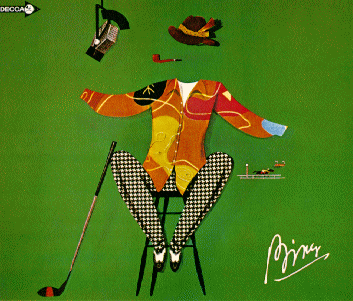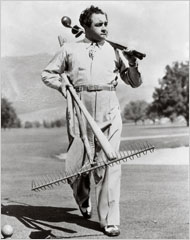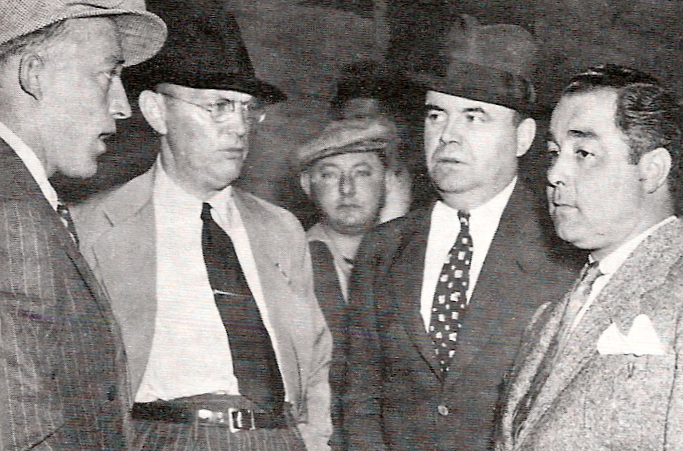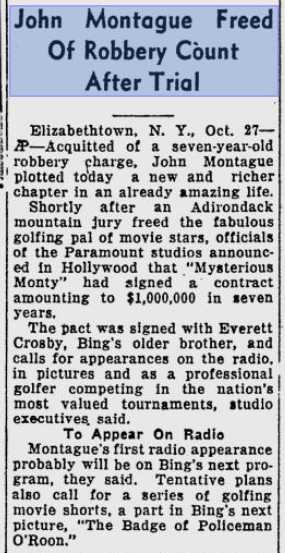
Bing's love of golf developed as a teenager when he caddied at a Spokane, Washington, golf course for 50 cents a bag. When he moved to Hollywood he joined the Lakeside Country Club in Los Angeles, where he developed a respectable golf game. At Lakeside in 1933 Crosby met the "mysterious" John Montague, a nearly unbeatable golfer who was intensely secretive and averse to photographers.
 The most storied incident on the Lakeside golf course was the one-hole match Montague staged with Bing Crosby. Already the country's most famous singer, not to mention a top movie star, Crosby was a constant and good golfer. He lived on Toluca Lake, sometimes played 36 holes in a day. Always looking for a match, one more round before sunset, he played against the Lakeside caddies, played against the members, played against Montague.
The most storied incident on the Lakeside golf course was the one-hole match Montague staged with Bing Crosby. Already the country's most famous singer, not to mention a top movie star, Crosby was a constant and good golfer. He lived on Toluca Lake, sometimes played 36 holes in a day. Always looking for a match, one more round before sunset, he played against the Lakeside caddies, played against the members, played against Montague.
At the end of one encounter, sharing drinks in the bar, Montague the winner again, Crosby bemoaned his luck. A bad bounce here, a bad lie there had ruined his game. Montague disagreed. He said a turn of luck would not have changed the result of the match. To prove it, he bet he could beat Crosby without even using golf clubs. He said he could beat him with a baseball bat, a shovel and a rake. Crosby jumped at the offer.
Montague went to his car -- and maybe Crosby should have suspected something if his opponent just happened to have a baseball bat, shovel and rake in the car -- and returned with the implements. He then proceeded to hit a golf ball 350 yards into a sand trap with the baseball bat, shovel the ball to within eight feet of the hole, then get down on all fours and make the putt for a birdie using the rake handle like a pool cue. This beat Crosby's par 4, which was executed with a normal drive, chip and two putts, all with standard clubs.
"That was enough for me," the singer said. "I went back to the clubhouse for a little more conviviality."
The Crosby story was wildfire. The tale was told and retold around Hollywood, exaggerated often, the match stretched to 18 holes in some accounts, the shots made longer and more difficult. The amount of the bet-- the two participants always claimed it was five bucks--turned into thousands. Montague was now forever "the man who beat Bing Crosby using a baseball bat, a shovel and a rake." (Montague THE Magnificent by Leigh Montville, Smithsonian, June 2008, Vol. 39, Issue 3)


Unfortunately for Montague, the most famous sportswriter in America, Grantland Rice, joined Lakeside in 1935. Rice wrote about the legendary exploits of Montague in his newspaper column, creating national interest that led to the exposure of his checkered past. "The Amazing Montague," whose real name was LaVerne Moore, was arrested in 1937 for an armed robbery of a New York restaurant in 1930. He was eventually acquitted with the help of money and a letter of reference from Bing. Following the acquittal, Bing tried to get "Monty" into one of his movies, but the Hollywood censors would have none of it. He tried to get "Monty" as a guest on his radio program, but the sponsor, Kraft, forbade it. After a few years of golf exhibitions "Montague" faded from the limelight, succumbed to alcoholism and died of a heart attack in poverty in a residence motel on May 25, 1972. His body went unclaimed at the morgue for a week. He was eventually buried in Holy Cross Cemetery, where Bing would be buried 5 years later. Bing never mentioned Montague or the Lakeside bat-rake-shovel incident in his autobiography, Call Me Lucky (1953), or in his 1975 authorized biography. It seems "Monty" had been officially written out of Bing's life.
In 1934 Bing began hosting his own tournaments. His first venture was with a group of invited friends on the 12-hole Old Brockway course near Lake Tahoe, California. Bing continued the tournament in 1935 before moving it to Rancho Santa Fe, near San Diego, where he developed the format of the celebrity pro-am golf tournament in 1937. The first tournament was called the Rancho Santa Fe Amateur-Pro. Later Bing became the first celebrity to give his name to a tournament.
"In the early thirties ... I joined a golf club called Lakeside. A very good course indeed, located out in North Hollywood. The membership was composed almost entirely of fellas in the entertainment business.... I was struck by the idea of putting together a pro-am competition where the Lakeside members ... could partner fifty or sixty invited professionals in a best ball event.... At that time I had a home and a small ranch down in San Diego County, near a nice golf course called Rancho Santa Fe, in the same region where I was involved in building and maintaining a race track known as Del Mar." (Bing Crosby, Foreword to The Crosby: Greatest Show in Golf by Dwayne Netland, p9)
The February 1937 tournament was rain-soaked and included amateurs Fred Astaire, Zeppo Marx, Richard Arlen and John Montague. Montague, however, did not play. Sam Snead, a green kid fresh out of the backwoods, emerged from the mud to become the first winner of a Crosby pro-am. When Bing presented Snead with the winner's check for $500 Snead replied, "If it's all the same to you, Mr. Crosby, I'd rather have the cash." Snead reprised his role as the champion the following year.
The final Crosby "clambake" at Rancho Santa Fe was played in 1942. The tournament was cancelled for the duration of World War II. It resumed in 1947 on the scenic Monterey Peninsula ("Pebble Beach"), where it remained through the remainder of Bing's life.
Through the years Bing's tournaments raised millions of dollars for various charities. Beginning in 1958 the tournament was broadcast nationally and frequently ranked as the most viewed golfing event of the year. One exception was 1974, when the tournament fell to fourth in the golf rankings, no doubt because Bing was seriously ill in the hospital for the duration.
After Bing's death his widow came under considerable pressure to change the name of the tournament to the AT&T Bing Crosby golf tournament. She refused, withdrew the Crosby name from the tournament, and set up a celebrity tournament for charities in Bing's name in 1986 in North Carolina.
The New York Times reported 23 April 1985, page 7:
The annual Bing Crosby National Pro-Am golf tournament, one of the oldest events on the PGA Tour, will no longer carry the singer's name because of a family decision yesterday to withdraw the Crosby affiliation. However, the four-day, 72-hole tournament involving tour golfers and amateurs will continue to be held on three courses on California's Monterey Peninsula under another name, according to Deane R. Beman, tour commissioner, and William Borland, chairman of the Monterey Peninsula Golf Foundation that conducts the event. Kathryn Crosby, Bing's widow, said the Crosby name was being withdrawn from the event because of "attempts to turn it into another corporate sideshow." In a statement released through Ben Langella, a family friend, Mrs. Crosby said: "For 40 years, Bing resisted all attempts to commercialize his yearly gathering of friends. Now the wrong elements have taken control of what was Bing's tournament, and they are determined to transform the Old Clambake into just another corporate sideshow for the PGA Tour."
The New York Times reported 29 January 1986, page 7:
When Kathryn Crosby learned that A.T.& T. had agreed last January to pay a salary to the chairman of the group that conducted the Bing Crosby National Pro Am golf tournament before the company assumed sponsorship of the event, the entertainer's widow considered it improper and used it as a reason to remove her husband's name from the tournament, according to Ben Langella, a Crosby family spokesman. ''The primary reason Kathryn Crosby took away Bing's name was because Bing had stipulated that the name of the tournament never be joined with a commercial company name,'' Langella said recently. ''But that salary thing to a board member was a big reason for taking Bing's name off it.'' The tournament, which begins Thursday at the Pebble Beach, Cypress Point and Spyglass Hill courses, is now known henceforth as the A.T.&T. Pebble Beach Pro-Am. The communications company has denied that it offered to pay any member of the board of directors of the Monterey Peninsula Golf Foundation, which conducts the tournament under contract to the PGA Tour.
Instead, Mrs. Crosby found a corporate sponsor, Sara Lee, to set up a celebrity tournament for charities in Bing's name in 1986 in North Carolina. In 2000 Sara Lee announced it could no longer afford to support the tournament. The final Crosby clambake was played at Bermuda Run, North Carolina, in June 2001. In 2006 Mrs. Crosby returned for the first time in 20 years to the Pebble Beach tournament, where she watched her two sons participate.
Bing was an avid hunter, fisher and conservationist. He appeared frequently on ABC-TV's "American Sportsman" series hosted by sportscaster Curt Gowdy. He owned a stable of race horses, and in 1937 helped finance the opening of a horse racing track at Del Mar near San Diego. Del Mar was the home of a famous race between Seabiscuit and Bing's horse, Ligaroti, in 1938, that was broadcast nationally and made into a movie and a book. Bing had to sell his interest in the track in 1947 when he purchased a quarter interest in a baseball team, the Pittsburgh Pirates. In 1953 he sold his stable of horses to pay the taxes on the estate of his first wife.
Bing's first year as co-owner of the Pirates saw them finish last in the National League, although they did set a club attendance record. Bing persisted, and lived to see his Pirates win the World Series in 1960 against the New York Yankees and in 1971 against the Baltimore Orioles.
Bing was in Europe during the 1960 World Series. Although the Yankees outscored the Pirates 55 to 27 in the series, Bill Mazeroski's dramatic bottom of the 9th inning home run in the final game defeated the Yankees 10-9. Bing listened to the series on radio in Europe, but he also arranged to have the NBC broadcast of the final game videorecorded. The recording was rediscovered in Bing's basement in 2010 -- the only complete videorecording of the game -- and was broadcast on cable television.
Fittingly, Bing died on a golf course in Spain, after finishing 18 holes, carding an 85, and defeating two Spanish golf pros. On the day of Bing's death, Major League Baseball paused for a moment of silence in Bing's honor at the start of World Series game three between the Los Angeles Dodgers and the New York Yankees.
Pebble Beach Pro-Am |||
More Bing FAQs ||| BCIM Home ||| Written by Steven Lewis
The most storied incident on the Lakeside golf course was the one-hole match Montague staged with Bing Crosby. Already the country's most famous singer, not to mention a top movie star, Crosby was a constant and good golfer. He lived on Toluca Lake, sometimes played 36 holes in a day. Always looking for a match, one more round before sunset, he played against the Lakeside caddies, played against the members, played against Montague.


